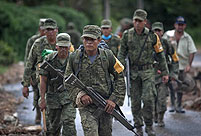Hundreds of Bangladesh garment factories again on Wednesday halted operations due to vandalism and blockades generated by workers in industrial zones of Dhaka for the fifth consecutive day to demand hike in minimum wage.
Some 50 people including garment workers and cops were injured as the unruly laborers fought pitched battles with the law enforcers and vandalized nearly a dozen vehicles in capital Dhaka' s Narayanganj, Gazipur and Savar industrial zones.
Like previous days, thousands of workers, who took to the streets on Wednesday, vandalized several garment units in the industrial hubs on the outskirts of the capital city.
Instead of joining their work places at 8:00 a.m. local time in the morning, they started demonstrations for hours in places of the industrial hubs defying incessant rains that lasted the entire day.
The unruly workers put barricades at different points on highways leading to the South Asian country's capital city.
Vehicular movement in the areas returned to normalcy after police pummeled the stone throwing workers to bring entire situation under control.
The ongoing workers' unrest stemmed Saturday when Garment Sramik Samannay Parishad, a federation of trade unions in garment sectors, organized a rally of over 50,000 workers to meet their different demands including raising minimum monthly salary to 8, 000 taka (about 102.56 U.S. dollars).
The Bangladeshi government for the last time in July, 2010, set 3,000 taka as the minimum monthly wage for the then over 2.5 million garment workers.
Bangladesh garment workers have long been protesting to demand higher wages and safe working conditions, but their protests have become much more common over the last few months after five factories collapsed on April 24 in which at least 1,130 people were confirmed dead.
The Savar tragedy revived questions about the commitments of factory owners and their global buyers to provide safe working conditions in the annually 20 billion U.S. dollars export sector, which comprises about 5,000 factories employing more than 4 million workers, 80 percent of whom are women.
 Storms leave 97 dead, 58 missing in Mexico
Storms leave 97 dead, 58 missing in Mexico New model of indigenous surface-to-air missiles testfired
New model of indigenous surface-to-air missiles testfired  118.28-carat diamond to be auctioned in HK
118.28-carat diamond to be auctioned in HK Maternal love under streetlight
Maternal love under streetlight Naked foreign student sits in the middle of a road in Haikou
Naked foreign student sits in the middle of a road in Haikou  Colorful Yunnan: Enjoy the natural beauty
Colorful Yunnan: Enjoy the natural beauty Harbin named Chinese city with most beautiful women
Harbin named Chinese city with most beautiful women New college students' military training in Guangzhou
New college students' military training in Guangzhou Rugby girls
Rugby girls PLA's 38th Group Army conduct training
PLA's 38th Group Army conduct training Residences of the royal house of Savoy
Residences of the royal house of Savoy The last days of Wan Aihua
The last days of Wan Aihua Highlights at 12th National Games of China
Highlights at 12th National Games of China Beijing Film Academy welcomes freshmen
Beijing Film Academy welcomes freshmen Large mahjong party sets new world record
Large mahjong party sets new world recordDay|Week|Month